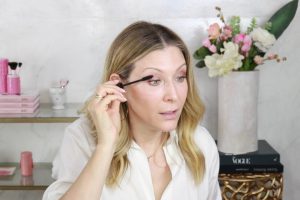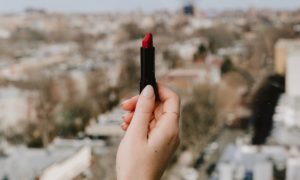Most recently updated 1/14/21
Transitioning to clean beauty would be a whole lot easier if there were some magic wand you could wave in front of your vanity and — poof — it would instantly replace any bottle containing concerning ingredients with a safer, better one. Save a few minor details (a highly scientific algorithm instead of a magic wand; a 3-minute poof instead of a 2-second one), the NakedPoppy assessment does precisely this, creating a clean and customized routine in front of your eyes.
If the thought of overhauling your skincare shelfie all at once is simply too overwhelming, though, don’t let that stop you from tip-toeing your way into nontoxic products. Start here, with the three items that will have the biggest payoff for you and the earth.
SPF
Sunscreen is a non-negotiable that’s vital for safeguarding your skin and your overall health. But conventional formulas are often loaded with disruptive chemicals, including oxybenzone and octinoxate. These two popular chemical sunscreen filters have been linked with hormone disruption and damage to coral reefs; the latter is why they’ve been banned in places like Hawaii, the U.S. Virgin Islands, and Key West, Florida.
There is also some concern that commonly used chemical filters can be absorbed into the bloodstream. Although two recent studies demonstrated this, they are still under debate, notes Marisa Plescia, NakedPoppy’s research scientist. So, the FDA has called for more research and declared that, for now, just two sunscreen ingredients are GRASE (Generally Recognized as Safe and Effective): titanium dioxide and zinc oxide.
Your cleanest bet when it comes to SPF, these mineral ingredients — found in the best-selling Suntegrity Impeccable Skin Tinted Sunscreen — work by physically blocking UV rays as opposed to absorbing and reflecting them like a chemical filter.
Serum
Of all the formulas we slather on our faces, serums are the ones that are actually designed to dive deep into skin. They’re packed with potent active ingredients of lower molecular weights so they can penetrate and get to work. That’s what makes them so effective, but that’s also what makes them potentially dangerous. If you’re not using a “clean” serum, what could you be absorbing?
Plescia points out that PEGs and ethoxylated ingredients are frequently added to serums to help blend oil-based ingredients with water-based ingredients. “This increases the risk of 1,4 dioxane contamination, a known carcinogen,” she adds. “Considering the demonstrated skin benefits of botanicals, a serum is a perfect opportunity to switch to a clean option utilizing natural ingredients with powerful results.” (Take the assessment to discover your ideal formula.)
Cleanser
Cleansers can contain a lot of misfit chemicals. There are sulfates, for starters — these suds-making ingredients can be irritating to skin and, even worse, become contaminated with the previously mentioned carcinogen 1,4 dioxane in the ethoxylation process. Due to their high water content, Plescia adds that “it’s essential that cleansers are properly preserved.” But widely used synthetic preservatives, including parabens and methylchloroisothiazolinone (say that three times fast), pose a problem.
“Parabens have been found to cause skin irritation and some scientific studies suggest that parabens can act as endocrine disrupters by mimicking estrogen in the body,” notes Plescia, “And the preservatives methylchloroisothiazolinone and methylisothiazolinone are often found in combination and have been linked to neurotoxicity and skin irritation/allergy.”
The fact that we use cleansers on wet skin — and let them wash down the drain — further complicates matters. When skin is wet, it’s more absorbent, so you need to be more mindful of what you use. And although you should weigh the environmental impact of everything you use, it’s especially important to do so when the product goes directly into the water supply. Studies have found everything from microplastics (remember the bead ban?) to synthetic fragrance molecules poisoning waterways and aquatic life.
Clean cleansers eschew all the chemicals mentioned above, and instead utilize plant-based ingredients that are safer for you and for the environment. For example, the NakedPoppy Nourish Cream Cleanser is made with skin-enhancing plant oils, gentle yet effective cleansing agents or “surfactants,” and clean preservatives. The NakedPoppy Refresh Foaming Cleanser also features clean, biodegradable surfactants and safe preservatives. Both formulas deep-clean your pores. Even better? They deep-clean your routine.
Get “shockingly accurate” clean beauty picks. Take your beauty assessment.
Shop the story:
References
[1] Oxybenzone and octinoxate have been linked with hormone disruption and damage to coral reefs:
https://www.sciencedirect.com/science/article/pii/S2214750017300288#bib0235
https://oceanservice.noaa.gov/news/sunscreen-corals.html
[2] Commonly used chemical filters can be absorbed into the bloodstream:
https://jamanetwork.com/journals/jama/fullarticle/2733085
https://jamanetwork.com/journals/jama/article-abstract/2759002
[3] Titanium dioxide and zinc oxide are the two sunscreen ingredients considered GRASE by the FDA:
https://www.fda.gov/news-events/fda-voices/shedding-more-light-sunscreen-absorption
[4] Parabens can act as endocrine disruptors by mimicking estrogen in the body:
https://onlinelibrary.wiley.com/doi/full/10.1002/jat.3917
[5] Methylchloroisothiazolinone and methylisothiazolinone have been linked to neurotoxicity and skin irritation/allergy: https://www.safecosmetics.org/get-the-facts/chemicals-of-concern/methylisothiazolinone/
[6] It’s especially important to weigh the environmental impact of products when they go directly into the water supply:
https://www.sciencedirect.com/science/article/pii/S2405665016300488
[7] Studies have found microplastics and synthetic fragrance molecules poisoning waterways and aquatic life:
https://www.congress.gov/bill/114th-congress/house-bill/1321/text






Comments